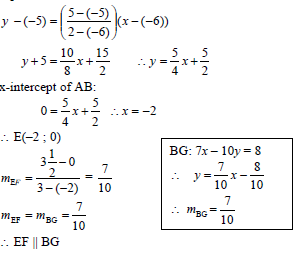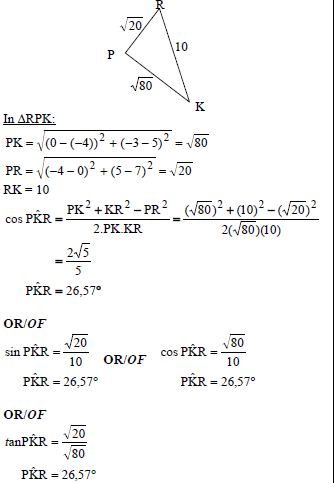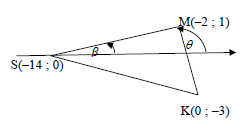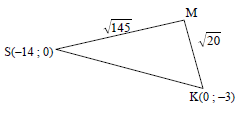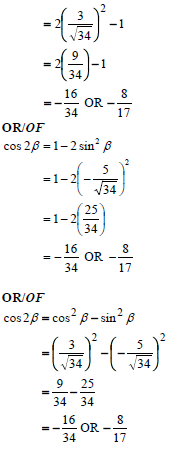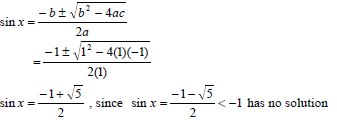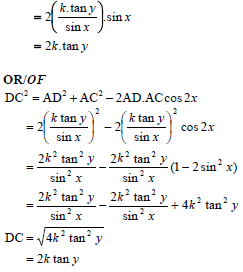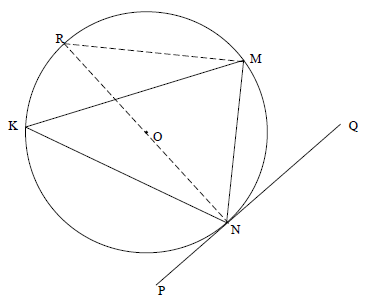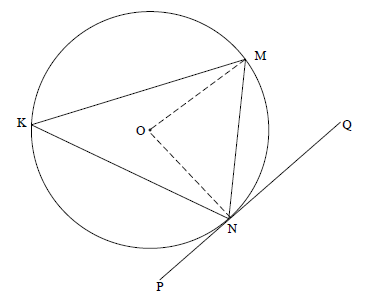GRADE 12 MATHEMATICS PAPER 2 MEMORANDUM - NSC PAST PAPERS AND MEMOS NOVEMBER 2017
Share via Whatsapp Join our WhatsApp Group Join our Telegram GroupMATHEMATICS PAPER 2
GRADE 12
NOVEMBER 2017
MEMORANDUM
NATIONAL SENIOR CERTIFICATE
NOTE:
- If a candidate answers a question TWICE, only mark the FIRST attempt.
- If a candidate has crossed out an attempt of a question and not redone the question, mark the crossed out version.
- Consistent accuracy applies in ALL aspects of the marking guidelines. Stop marking at the second calculation error.
- Assuming answers/values in order to solve a problem is NOT acceptable.
| GEOMETRY | |
| S | A mark for a correct statement (A statement mark is independent of a reason.) |
| R | A mark for a correct reason (A reason mark may only be awarded if the statement is correct.) |
| S/R | Award a mark if the statement AND reason are both correct. |
QUESTION 1
| Time for 100 m sprint (in seconds) | 10,1 | 10,2 | 10,5 | 10,9 | 11 | 11,1 | 11,2 | 11,5 | 12 | 12 | 12,2 | 12,5 |
| Distance of best long jump (in metres) | 8 | 7,7 | 7,6 | 7,3 | 7,6 | 7,2 | 6,8 | 7 | 6,6 | 6,3 | 6,8 | 6,4 |
| 1.1 | a = 14,343… = 14,34 b = –0,642… = – 0,64 | ✓✓ value of a ✓ value of b (3) |
| 1.2 | Y = 14,42 - 0,64(11,7) OR y = 6,83 (calculator) | ✓ substitution correctly ✓ answer (2) ✓✓answer (2) |
| 1.3 | The gradient increases The point (12,3 ; 7,6) lies some distance above the current data. | ✓ increases ✓ reasoning in words (2) |
[7]
QUESTION 2
| 12 | 13 | 13 | 14 | 14 | 16 | 17 | 18 | 18 | 18 | 19 | 20 |
| 21 | 21 | 22 | 22 | 23 | 24 | 25 | 27 | 29 | 30 | 36 |
| 2.1.1 | x = 472 23 x = 20,52 seconds | ✓ 472 23 ✓ answer (2) |
| 2.1.2 | Q1 = 16 Q3 = 24 IQR = Q3 – Q1 = 24 – 16 = 8 | ✓ Q1 ✓ Q3 ✓ answer (3) |
| 2.2 | 20,52 + 5,94 = 26,46 ∴ > 26,46 ∴ 4 girls | ✓ 26,46 ✓ answer (2) |
| 2.3 | ✓ whiskers ending at 12 & 36 ✓ Q1 = 16 & Q3 = 24 (box) ✓ Q2 = 20 (3) | |
| 2.4.1 | Girls | ✓ answer (1) |
| 2.4.2 | Five-number summary of boys: (15 ; 21 ; 23,5 ; 26 ; 38) None of the boys 5 girls completed in less than 15 seconds which was the minimum time taken by the boys. | ✓ answer ✓ reason/(2) |
[13]
QUESTION 3
| 3.1.1 | mFC = y2 - y1 x2 - x1 = 3½-(-4) 3-8 = - 3 2 y = mx + c y - y1 = m(x-x1) y = - 3 x + c 2 -4=- 3 (8) + c OR (y-(-4))=- 3 (x + 8) 2 2 y = - 3 x+8 y+4 = - 3 x + 12 2 2 y = - 3 x + 8 y=- 3 x + 8 2 2 OR 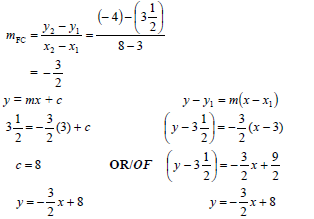 | ✓ substitution of (8 ; –4) & (3;3½) ✓ substitution of (8 ; –4) & (3;3½) |
| 3.1.2 | AC: 3x + 2y = 16 and BG: 7x – 10y = 8 | ✓ method:solving simultaneously
✓ method: equating |
| 3.2 | x4 + 4 =3 and yA + 2 = 3½ 2 2 ∴ A(2 ; 5) OR by translation: xA = 3-(4-3) = 2 yA = 3½+(3½-2)=5 ∴ A(2 ; 5) | ✓ equation ito x
✓ equation ito x |
| 3.3 | The coordinates of the midpt of AB: | ✓ subst A & B into midpt formula ✓ subst A & B into midpt formula ✓ equation of AB |
| 3.4 | Midpoint of AC = (5;½) | ✓✓(5;½) |
QUESTION 4
| 4.1.1 | mPK = 5 - (-3) -4 - 0 =-2 PK ⊥ SR [radius ⊥ tangent] ∴ mPK x mRS = -1 ∴ mRS = ½ | ✓ substitution P & K into gradient formula ✓ gradient of PK ✓ PK ⊥ SR OR r ⊥ tangent ✓ answer (4) |
| 4.1.2 | y = ½x + c 5 = ½(-4) + c OR (y-5) = ½(x-(-4)) c = 7 (y - 5) = ½x + 2 y = ½x+7 y = ½x + 7 | ✓ substitution of m and P ✓ equation (2) |
| 4.1.3 | M(–2 ; 1) ∴ r 2 = (x2 - x1 )2 + ( y2 - y1 )2 r 2 = (-2 + 4)2 + (1 - 5)2 ∴ r 2 = 20 ∴(x + 2)2 + ( y - 1)2 = 20 or √( 20)2 OR (x + 2) 2 + ( y - 1) 2 = r 2 (-4 + 2) 2 + (5 - 1) 2 = r 2 ∴ r 2 = 20 ∴ (x + 2)2 + ( y - 1)2 = 20 or √( 20)2 OR | ✓x value of M ✓y value of M
✓✓M (– 2 ; 1)
✓✓M (– 2 ; 1) ✓r 2 = 20 ✓equation (4) |
| 4.1.4 | tanθ = mPK = -2 ∴ q = 180° – 63,43° = 116,57° PKR = 116,57° - 90° [ext ∠ of ΔMOK] = 26,57° | ✓tanθ = -2 ✓size of q
✓lengths of PK, PR & RK
✓lengths of sides
✓lengths of sides |
| 4.1.5 | RS || tangent at K(0 ; – 3 ) ∴ mPS = mtang =½ ∴ y = ½ x - 3 OR mPK = 1- 5 = -2 mPK x mtang = -1 [radius ⊥ tangent] ∴ mtan g = ½ ∴ y = ½ x - 3 | ✓gradient ✓equation (2)
✓gradient ✓equation (2)
|
| 4.2 | t ∈ (-3 ; 7) OR | ✓– 3 (A) ✓– 3 (A)
|
| 4.3 | RS: y = ½ x + 7 ∴S(–14 ; 0) OR OR cosSMK = (√145)2 + (√20)2 - (√205)2 = - 2√29 OR | ✓coordinates of S
✓coordinates of S
✓coordinates of S
✓coordinates of S (5)
|
QUESTION 5
5.1 | sin(A - 360°).cos(90° + A) = sinA(-sinA) | ✓sin A |
5.2.1 | t 2 = (√34) 2 - (3) 2 | ✓substitution |
5.2.2 | tan b = - 5 | ✓correct ratio(1) |
5.2.3 | cos2b = 2 cos2 β - 1 | ✓compound formula
✓compound formula
✓compound formula |
| 5.3.1 | LHS = sin(A + B) – sin(A – B) | ✓compound formula |
| 5.3.2 | sin 77° - sin 43° = sin(60° + 17°) - sin(60° - 17°) | ✓60° + 17°
✓60° + 17° [19] |
QUESTION 6
| 6.1 |  | ✓(–90° ; –3) | ||
6.2 | cos 2x = 2 sin x - 1 | ✓cos 2x = 1- 2 sin 2 x | ||
6.3 | sin x = - 1 + √5 = 0,618... | ✓38,17° | ||
QUESTION 7
7.1 | ABˆ C = 90° | ✓answer (1) |
7.2 | In D ABE: AB = k tan y In D ABC: AB = sin x AC = AB = k tan y | ✓correct ratio |
| 7.3 | ADˆ C = ACˆ D = 180° - 2x = 90° - x OR DC2 = AD2 + AC2 - 2AD.ACcos 2x | ✓90° - x ✓substitution into cos rule ✓correct cos rule [10] |
QUESTION 8
8.1.1 | E = 50°- 15° = 35° [ext ∠ of D] OR | ✓S ✓S ✓ R (3) ✓S ✓S ✓ R (3) |
8.1.2 | C2 = 35° [Ðs in same segment] | ✓S ✓R (2) |
8.2 | C2 = E [from 8.1.1 and 8.1.2] | ✓S |
QUESTION 9
9.1.1 | AF = 3x = 3 & AG = 12y = 3 ∴ AF = AG ∴ FG || BC [conv prop th. OR line divides 2 sides of ∆ in prop] | ✓ AF = AG ✓ R (2) |
9.1.2 | AG = AH [prop theorem; GH || CK OR ∴ AH = AE | ✓S ✓R ✓ S (3) |
9.2 | AE = 3 and AH = 3 AE = 3 and 15 = 3 ∴ AE = 18 and HK = 10 AD = 30 ∴ EK = HK – HE EK = ED – KD | ✓use of ratios [10] |
QUESTION 10
10.1 | Line from centre to midpoint of chord | ✓ R (1) |
10.2.1 | OWT = OWS = 90° [radius ^ tangent] | ✓ R ✓ R (2) |
10.2.2 | M1 = N1 [∠s opp = sides] OR | ✓ S ✓ S |
| 10.2.3 | In ΔOVN and ΔOWS ∴ VN = ON OR OR | ✓S; S; S OR
✓S; S; S OR
✓✓similarity [12] |
QUESTION 11
11.1 | Construction: Draw diameter NR and draw RM but MRN = MKN [Δs same segment] OR | ✓construction |
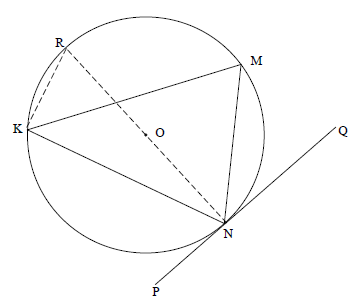
11.1 | Construction: Draw diameter NR and draw RK | ✓construction |
11.1 | Construction: Draw radii ON and OM | ✓construction |
11.2

11.2.1(a) | Angle in a semi circle | ✓R (1) |
11.2.1(b) | Exterior ∠ of quad = opp interior | ✓R (1) |
11.2.1(c) | tangent chord theorem | ✓R (1) |
11.2.2(a) | In ΔAEC | ✓S (3) |
11.2.2(b) | In ΔADB and ΔACD OR | ✓S
✓S |
| 11.2.3(a) | AD = AB [||| ∠s] AD2 = AC . AB | ✓ratio |
| 11.2.3(b) | AD = AE = √3r [from 11.2.2(a) &11.2.3(a)] OR OR | ✓AC ito r
✓√3r = DB
✓BD = CD (4) [20] |
TOTAL:150


